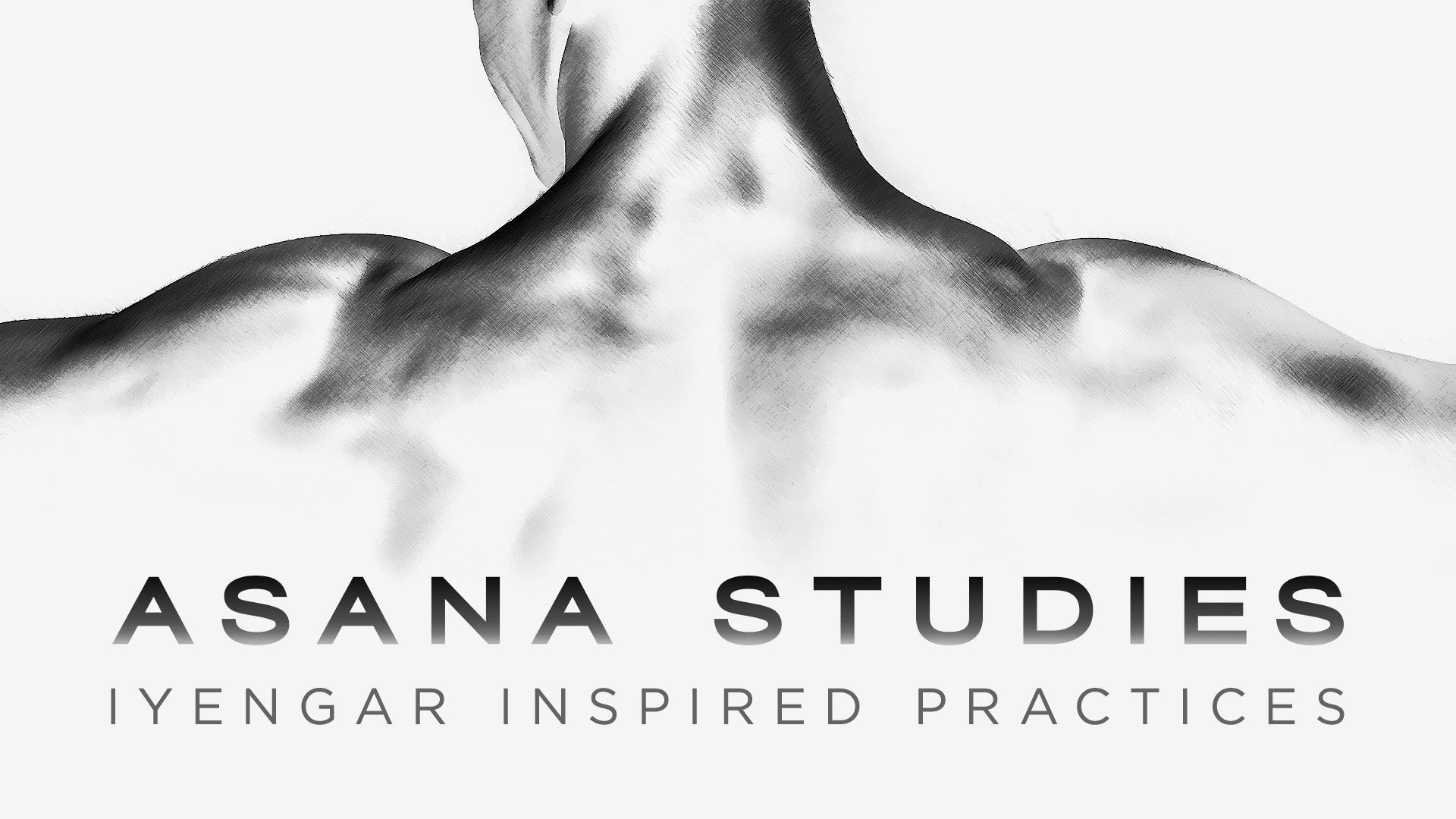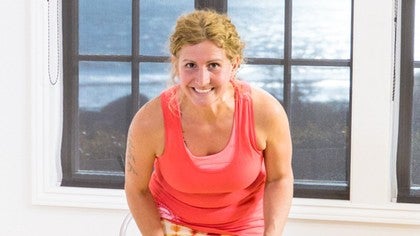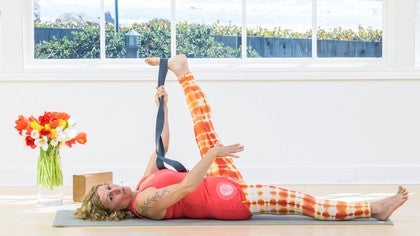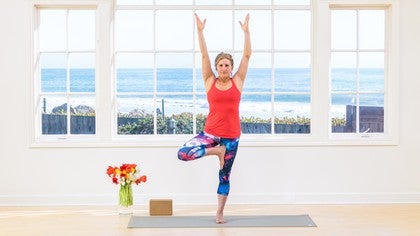Description
About This Video
Transcript
Read Full Transcript
(waves lapping) Hello and welcome. We are going to take some time to look at the pelvis. So we're first going to look at the bony landmarks of the pelvis, and then we'll look at the muscle groups, just so we know what it is that we often hear about in yoga class. We hear these bony landmarks or muscle groups said, and we don't always know where they are. So let's take our hands, onto sort of the front of the pelvis.
So we've heard hip points, so we're gonna bring our hands to the front of the pelvis, and just feeling around, so the bony landmark is quite large and there's much tissue attached to that. And then let's bring the hands onto the we call them the iliac crest and just shift side to side so that you can feel where the bone is and where the bone ends; tissue begins. You can walk your hands all the way around to the back, and about where your thumbs touch is where your ilium, or your hip bones, connect to the sacrum. The sacrum's a long, triangular bone. You have the coccyx at the bottom of the sacrum.
So you have two joints at the back of the pelvis, and we come walk around back to the front hip points and down, and in, we find the pubis. So, back of the pelvis, front of the pelvis. If you lift your right knee up, or one knee, looking for the bony landmark at the bottom-most part of your pelvis, you can even step down and see if you can still feel it. And lift up, and step down, and see how the awareness of it changes once you step down and the tissue gets involved. So coming back to the top of the iliac crest, walking your hands down, and just shifting side to side so that you feel again the bone pushing out against the skin.
So this is the top of your femur bones, the greater trochanter. So the femur bones tend to move out, they angle out to connect to the hip joint. And the hip joint is about at the level of the greater trochanter, maybe a little higher but deep in the pelvis. So those are basic bony landmarks within the pelvis. So now let's talk about the soft tissue or the muscle groups.
So quadriceps on the front of the leg, so when you lift your leg, one of them crosses the hip. The rest of them, four of them cross the knee. And just feeling this kind of mass of muscle, strong muscle. And then the counter of that is the hamstrings on the back. So all the hamstrings attach to the ischial tuberosities and cross below the knee and attach on the lower leg.
And again, just feeling the bulk of that muscle. So the relationship of those two muscles helps steer the pelvis. When one is short, it affects the pelvis in one direction, and when it is long, if the hamstrings are long, there's a little more lift in the back of the pelvis. When they're short, there's a little more tug in the back of the pelvis, tucked down. So other muscle groups, we have our adductors.
If you hug your leg, let's turn the knee out and just hug the leg in against your hand you can feel that strong mass of muscle. The adductors, they're pulling everything towards the midline. And they attach from the inner inside of the femur to the pubis. And the abductors, their counterpart, let's put your hand on the outer hip. So just shifting onto one leg, let's take the right leg out and up and just feeling that tissue fire up.
So these muscles pull the leg out, and the inner thigh pulls the leg in. So one other interesting relationship to look at is again just how the pelvis is affected by the strength of the leg. So when the legs are turned out, you can feel, bring your hands to the back of the pelvis and you can feel just the strength of the tissue in the back of the body and how much it can pull the pelvis down. So as I do that, as I exaggerate the movement, I can feel the back of the pelvic floor getting quite taut. And as I turn the feet in, exaggerate, kinda pulling the legs in or turning the legs in, I can feel the inner legs in the frontal leg get tight and pull the front of the pelvis forward.
And so the effect on the pelvic floor as the leg is negotiating in space and how that affects and pulls on the pelvis. So what we're trying to do in our asana practice is affect the postural patterns. We're trying to affect, or negate what we do all day long. The abdominal pattern, so the abdominals are in the front. We have the back muscles in the back, we have many layers of back muscles here.
And then we have the psoas, which attaches to the front of the spine and moves down through the pelvis and attaches on to the lesser trochanter right up in the groin. So we have these three levels, three layers of muscle that have to balance how the pelvis stands on the legs. And so between these kind of strong levers of the legs and these strong levers of the psoas, the back, and the belly, affects how we hold our pelvis in space. So I'm just going to come sit on a chair. It helps if the chair is padded, or you have a blanket on the chair so that you can put your hand, I'm gonna go under my buttocks I'm gonna find my ischial tuberosity again.
Try to relax. And I just want to feel. The tissue space between the two sitz bones, I'm only using one hand but just imagining the other sitz bone, feeling where my tailbone was, you can even bring your hand back to the bottom of the sacrum. Walk your hand down and find the tip of the tailbone. If you walk the hand forward, find the pubis.
So that tissue between the two sitz bones, the pubis and the tailbone, involves the pelvic floor. So we have the perineum or the most superficial layer of the pelvis, and then we have a deeper layer. So it's not really that important to know how many layers, but I'm gonna actually move my hand up and I'm going to the inside of the ischial tuberosity and up just to get a sense, not really touching the pelvic floor, but I'm moving towards it. Just to get a sense of the tissue there. Then you can even move your hand forward and back and feel, as I do this, I can feel the effect or the relationship of the pelvic floor to my lower back, to my inner leg, to the front of the groin.
Good. And just slowly release. So, even if you don't understand exactly what's happening in your pelvis, what pain does is it gives us an indication that something's off-balance or uncomfortability and so what we get to do with that is take a step back, slow down our movements, question... and play with finding a different way of movement. So thanks for coming.
Asana Studies: Padma Borrego
Comments

You need to be a subscriber to post a comment.
Please Log In or Create an Account to start your free trial.







